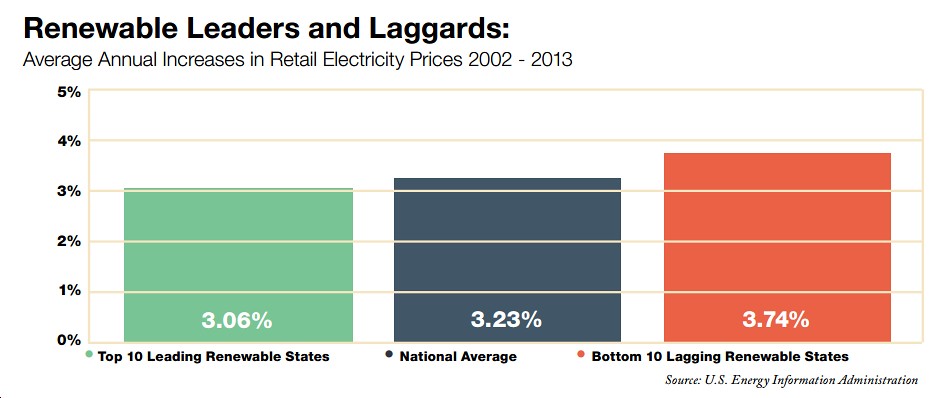
Another day, yet another strong piece of evidence that sticking with a fossil-fuel-heavy power generation portfolio isn’t just bad for the environment and for people’s health, it’s also bad for the bottom line. This time, it’s a study by DBL Investors, entitled “Renewables Are Driving Up Electricity Prices? WAIT, WHAT?” The key takeaway is as follows:
… states with the greatest share of electricity generation from renewable sources have often experienced average retail electricity prices that are cheaper than both the national average and also states with the smallest share of electricity generation from renewable sources.
In 2013, U.S. states generated electricity from renewable sources at a variety of different levels. And yet, as the graph below demonstrates, greater generation from renewables did not mean skyrocketing electricity prices. In fact, states generating more electricity from renewables often experienced average retail electricity prices well below states producing less electricity from renewables.
Or, as this article puts it, “states boasting robust green energy programs have the nation’s cheapest electricity,” and “trend lines suggest it’s only going to get better for their consumers.” Actually, switching to renewable energy at this point is basically a no-brainer, that is if you want an inexhaustible, clean, and increasingly cheap form of power for your state. Keep in mind that:
*The cost of wind power has decreased 58% over the past 5 years, and there’s no reason to think that improvements in wind technology and cost will end anytime in the foreseeable future.
*The cost of solar power has been plummeting, down 78% between 2009 and 2014, and that trend is highly likely to continue indefinitely, utlimately leading to the “singularity”, in which “solar power will be close to free in the coming decades.”
*As for natural gas, which some people foolishly want to lock us into for decades to come, it’s cheap right now, but that is highly unlikely to continue. Also, as this article notes, the price of natural gas is highly volatile, to the extent that it “can increase by a factor of six over the course of five years, then decrease by the same amount in four years.”
*Finally, of course, energy efficiency continues to be the cheapest form of energy that exists — far, far less expensive than a new coal-fired power plant, for instance, and without any of the environmental damage that comes with coal.
As always, the lesson here is that you shouldn’t believe anything the entrenched, “incumbent” fossil fuel companies try to tell you about renewable energy, as they’ve got it exactly backwards. Of course, as Upton Sinclair said, “It is difficult to get a man to understand something, when his salary depends on his not understanding it.” That certainly helps explain the disinformation coming out of the fossil fuel industry folks and their political allies. As for the rest of us, our futures depend on understanding that clean and cheap energy, not dirty and expensive fossil fuels, represent the future for our states, our country and the planet.



 Sign up for the Blue Virginia weekly newsletter
Sign up for the Blue Virginia weekly newsletter
![Rep. Eugene Vindman (D-VA07) Has Mostly Been Excellent So Far, But Being One of “35 House Democrats [Who] Joined Republicans Against a Major Climate Policy” Is Not Cool. At All.](https://bluevirginia.us/wp-content/uploads/2025/05/nytcalifornia-238x178.jpg)






![Rep. Eugene Vindman (D-VA07) Has Mostly Been Excellent So Far, But Being One of “35 House Democrats [Who] Joined Republicans Against a Major Climate Policy” Is Not Cool. At All.](https://bluevirginia.us/wp-content/uploads/2025/05/nytcalifornia-100x75.jpg)